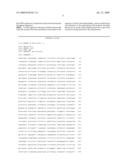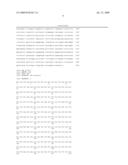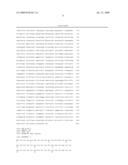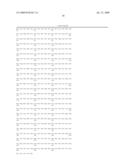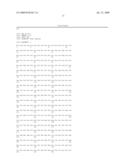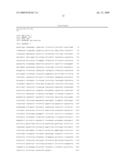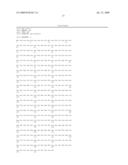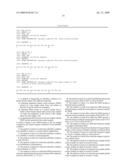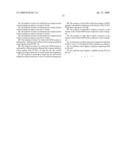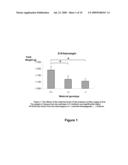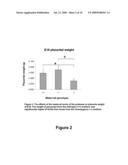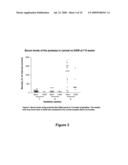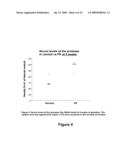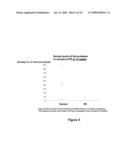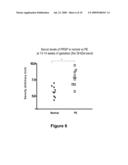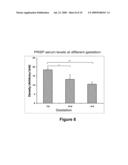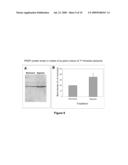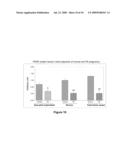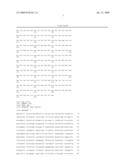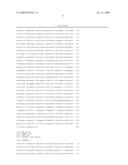Patent application title: DIAGNOSIS OF FERTILITY CONDITIONS USING A SERINE PROTEASE
Inventors:
Guiying Nie (Glen Waverly, AU)
Lois Adrienne Salamonsen (Kew, AU)
IPC8 Class: AG01N33573FI
USPC Class:
435 74
Class name: Measuring or testing process involving enzymes or micro-organisms; composition or test strip therefore; processes of forming such composition or test strip involving antigen-antibody binding, specific binding protein assay or specific ligand-receptor binding assay to identify an enzyme or isoenzyme
Publication date: 2009-07-23
Patent application number: 20090186367
Claims:
1. A method of diagnosing an infertility condition in a human female
subject, the method comprising(a) detecting pregnancy-related serine
protease (PRSP) protein in a test sample taken from said subject at
between 8 and 20 weeks into pregnancy;(b) detecting PRSP protein in a
control sample from a fertile control human female taken at the same
number of weeks into pregnancy in the control as the sample taken from
the subject; and(c) comparing the PRSP protein in the test sample with
the PRSP protein detected in the control sample,in which a change in the
PRSP protein in the test sample compared to the control sample is
indicative of an infertility condition.
2. The method of claim 1 in which the infertility condition is an inability to achieve or sustain embryo implantation.
3. The method of claim 1 in which the infertility condition is an inability to sustain a normal pregnancy.
4. The method of claim 3 in which the infertility condition is early abortion.
5. The method of claim 1 in which the infertility condition is an insufficiency of placentation.
6. The method of claim 5 in which the infertility condition is pre-eclampsia or IUGR.
7. The method of claim 1 in which the PRSP protein has a sequence selected from the group consisting of the sequences set out in SEQ ID NO: 2, 5, 6 or 8.
8. The method of claim 7 in which the PRSP protein has the sequence set out in SEQ ID NO:5 or SEQ ID NO:6
9. The method of claim 1 in which the PRSP protein is detected using an antibody.
10. The method of claim 9 in which the PRSP protein is detected using an antibody raised against a sequence specific for PRSP.
11. The method of claim 10 in which the PRSP protein is detected using an antibody raised against SEQ ID NO: 10.
12. The method of claim 9 in which the PRSP protein is detected using an antibody raised against amino acids 133 to 142 or 116 to 126 of SEQ ID NO: 2.
13. The method of claim 1 in which the biological sample is a sample of biological fluid.
14. The method of claim 13 in which the biological fluid is plasma, serum, uterine or bladder washings or amniotic fluid.
15. The method of claim 1 in which the biological sample is a tissue or cellular sample or extract thereof.
16. The method of claim 15 in which the sample is placental or uterine tissue.
17. The method of claim 1 in which the test sample and the control sample are taken at around 8 weeks.
18. The method of claim 1 in which the test sample and the control sample are taken at around 9 weeks.
19. The method of claim 1 in which the test sample and the control sample are taken at around 10 weeks.
20. The method of claim 1 in which the test sample and the control sample are taken at around 11 weeks.
21. The method of claim 1 in which the test sample and the control sample are taken at around 12 weeks.
22. The method of claim 1 in which the test sample and the control sample are taken at around 13 weeks.
23. The method of claim 1 in which the test sample and the control sample are taken at around 14 weeks.
24. The method of claim 1 in which the test sample and the control sample are taken at around 15 weeks.
25. The method of claim 1 in which the PRSP protein is indicated by a 39 kDa band on Western blot using an antibody raised against SEQ ID NO: 10.
26. The method of claim 1 in which the PRSP protein is indicated by a 30 kDa band on Western blot using an antibody raised against SEQ ID NO: 10 and the test and control samples are taken at between 13 and 20 weeks into pregnancy.
27. The method of claim 26 in which the test and control samples are taken at between 13 and 14 weeks into pregnancy.
28. The method of claim 25 in which the change in PRSP protein is identified by a decrease in the density of the 39 kDa PRSP band indicative of IUGR.
29. The method of claim 25 in which an increase in the density of the 39 kDa PRSP band is indicative of pre-eclampsia.
30. The method of claim 26 in which a decrease in the density of the 30 kDa PRSP band is indicative of pre-eclampsia.
31. A null mouse in which expression of genes having SEQ ID NO: 1 and or 7 is blocked in which said genes are deleted.
32. An antibody raised against a peptide comprising SEQ ID NO:10.
33. An antibody raised against a peptide having SEQ ID NO:10.
Description:
RELATED APPLICATION
[0001]The present application claims the priority of co-pending provisional application U.S. Ser. No. 61/015,956, filed Dec. 21, 2007. The disclosure of the aforementioned application is incorporated by reference herein in its entirety, and applicants claim the benefits of this application under 35 U.S.C. §119(e).
FIELD OF THE INVENTION
[0002]This invention relates to the evaluation of fertility and monitoring of early pregnancy, fetal development, placental development and function, parturition, and conditions such as pre-eclampsia, intrauterine growth restriction (IUGR), early abortion and abnormal uterine bleeding using a protease.
BACKGROUND OF THE INVENTION
[0003]Embryo implantation, the process by which the blastocyst attaches and implants in the uterus, leads to the establishment of an intimate relationship between the embryo and the endometrium. Implantation is one of the most important limiting factors in establishing a successful pregnancy. It is a complex process involving active interactions between the blastocyst and the uterus. The uterus must undergo dramatic morphological and physiological changes to transform itself from a non-receptive to a receptive state. This differentiation process is largely mediated by the coordinated effects of the ovarian hormones, which act through their intracellular receptors to regulate gene expression, and hence to influence cellular proliferation and differentiation. It is also regulated by the blastocyst.
[0004]While the details of the exact molecular events occurring in the uterus during this differentiation process towards receptivity are still unknown, in principle it can be predicted that a unique set of genes is up- or down-regulated in a temporally and spatially specific manner. Indeed, induction of specific genes in the uterus during the peri-implantation period, including those encoding some growth factors and cytokines, has been reported. However, given the complexity and the as-yet imprecisely defined molecular mechanism of the process, many other molecules critical for implantation are still unidentified.
[0005]In their earlier application U.S. Ser. No. 10/485,313 (which is herein incorporated in its entirety by reference) the inventors used the mouse as a model in a search for molecules important in the early stage of implantation. In the mouse on day 4.5 of pregnancy (vaginal plug=day 0), the uterus undergoes dramatic morphological changes in association with cell proliferation and differentiation, leading to the acquisition of a receptive state. This uterine remodeling is associated with an increase in vascular permeability at implantation sites. The inventors hypothesized that the proliferation and differentiation of endometrial cells at this time is associated with up- or down-regulation of a number of genes.
[0006]To identify uterine genes which are potentially critical for uterine receptivity, the inventors used the technique of RNA differential display (DDPCR) and compared the mRNA expression patterns of implantation and interimplantation sites on day 4.5 of pregnancy (Nie G, Li Y, Batten L, Griffiths B, Wang J, Findlay J & Salamonsen L A (2000) Uterine expression of alternatively spliced mRNAs of mouse splicing factor SC35 during early pregnancy. Mol. Hum. Reprod. 6: 1131-1139). One of the mRNA molecules identified as being differently regulated between the two sites was found to encode a protein molecule, with a predicted serine protease motif. This protein was significantly homologous to SEQ ID NO: 3 described in WO 00/39149 (Barnes), and had significant homology to HtrA type proteins. These proteins were not previously suggested to be involved in embryo implantation.
[0007]Accordingly, further work was performed to identify the role of this protein in pregnancy and to identify potential uses. The cDNA encoding this protein was isolated, and its uterine expression during early pregnancy in the mouse examined; the protein is up-regulated in the pregnant mouse uterus from day 4.5 and further increased in the implantation site (including the maternal deciduum and the fetus and the placenta) from day 8.5 onwards. The observed expression pattern indicated a role for this protein in implantation, placentation and early pregnancy.
[0008]It is an aim of a preferred embodiment of the present invention to further study the role of serine proteases in fertility and to develop tools for such study. It is also an aim of a preferred embodiment of the invention to provide a test for fertility related disorders.
SUMMARY OF THE INVENTION
[0009]In a first aspect the invention provides a method of diagnosing an infertility condition in a human female subject, the method comprising
(a) detecting pregnancy-related serine protease (PRSP) protein in a test sample taken from said subject at between 8 and 20 weeks into pregnancy;(b) detecting PRSP protein in a control sample from a fertile control human female taken at the same number of weeks into pregnancy in the control as the sample taken from the subject; and(c) comparing the PRSP protein in the test sample with the PRSP protein detected in the control sample,in which a change in the PRSP protein in the test sample compared to the control sample is indicative of an infertility condition.
[0010]In an embodiment of the first aspect, the infertility condition is an inability to achieve or sustain embryo implantation, or an inability to sustain a normal pregnancy, such as early abortion, or an insufficiency of placentation, such as pre-eclampsia or IUGR.
[0011]In another embodiment of the first aspect, the PRSP protein has a sequence selected from the group consisting of the sequences set out in SEQ ID NO:2, 5, 6 or 8.
[0012]In another embodiment of the first aspect, the PRSP protein is detected using an antibody. In one embodiment the antibody is raised against a sequence specific for PRSP, such as SEQ ID NO:10, or amino acids 133 to 142 or 116 to 126 of SEQ ID NO:2.
[0013]In another embodiment of the first aspect, the biological sample is a sample of a biological fluid, such as plasma, serum, uterine or bladder washings, or amniotic fluid or a tissue or cellular sample or extract thereof, such as placental or uterine tissue.
[0014]In another embodiment of the first aspect, PRSP protein in the test and, or control samples is indicated by a 39 kDa PRSP band on Western blot using an antibody raised against SEQ ID NO: 10.
[0015]In another embodiment of the first aspect, PRSP protein in the test and, or control sample is indicated by a 30 kDa band on Western blot using an antibody raised against SEQ ID NO: 10 when the test and control samples are taken at between 13 and 20 weeks into pregnancy.
[0016]In another embodiment of the first aspect, the change in PRSP protein is indicated by a decrease in the density of the 39 kDa PRSP band, indicative of IUGR.
[0017]In another embodiment of the first aspect, the change in PRSP protein is indicated by an increase in the density of the 39 kDa PRSP band, indicative of pre-eclampsia.
[0018]In another embodiment of the first aspect, the change in PRSP protein is indicated by a decrease in density of the 30 kDa band, indicative of pre-eclampsia.
[0019]In their earlier application U.S. Ser. No. 10/485,313 (PCT/AU02/01010) the inventors described isoforms of a serine protease whose expression is upregulated at the site of embryo implantation during early pregnancy. This enzyme was described as a pregnancy related serine protease, or PRSP. It was proposed that this protein could be used in an assay to diagnose infertility conditions.
[0020]Several sequences for serine proteases upregulated at the site of embryo implantation during early pregnancy have been identified and these have substantial sequence homology to proteins of the HtrA family. Suitable PRSP proteins and nucleic acid molecules encoding them are provided as SEQ ID Nos: 1-8.
[0021]The inventors have now determined the timing of the upregulation in expression of this protein in a normal pregnancy and accordingly have identified the key time points between which any sample should be taken to assay for the serine protease to diagnose infertility conditions. From experimental evidence, the best time to take a sample upon which to assay for PRSP is 8-20 weeks, with the period between 8-14, 8-10 and 8-9, or 13-14 weeks being particularly preferred. Tests performed on samples taken at 9 weeks into pregnancy have been shown to be able to diagnose between IUGR and pre-eclampsia.
[0022]In a second aspect the invention provides a null mouse model in which expression of serine protease genes having SEQ ID NO:1 and 7 and therefore serine protease proteins having SEQ ID NO: 2 or 8, is blocked. Preferably, the null mouse has the genes having SEQ ID NO: 1 and or 7 deleted.
[0023]In a third aspect the invention provides an antibody raised against a peptide comprising SEQ ID NO: 10.
[0024]In a fourth aspect the invention provides an antibody raised against a peptide having SEQ ID NO: 10.
[0025]In a fifth aspect the invention provides the use of the antibody of the third aspect in the method of the first aspect.
[0026]In a sixth aspect the invention provides the use of the antibody of the fourth aspect in the method of the first aspect.
BRIEF DESCRIPTION OF THE FIGURES
[0027]FIG. 1 shows the effects of maternal levels of the protease on fetal weight at E18.
[0028]FIG. 2 shows the effects of maternal levels of the protease on placenta weight at E18.
[0029]FIG. 3 shows serum levels of the protease (the 39 kD band) at 7-9 weeks of gestation.
[0030]FIG. 4 shows serum levels of the protease (the 39 kD band) at 9 weeks of gestation.
[0031]FIG. 5 shows serum levels of the protease (the 30 kD band) at 14 weeks of gestation.
[0032]FIG. 6 shows serum levels of the protease (the 39 kD band) at 13-14 weeks of gestation.
[0033]FIG. 7 shows cellular localization and expression levels of the protease in placental/maternal cells across gestation.
[0034]FIG. 8 shows serum levels of the protease in maternal blood across gestation.
[0035]FIG. 9 shows protease levels in the media of explant culture of first trimester placenta.
[0036]FIG. 10 shows protein levels of the protease in term placenta of normal and PE pregnancy.
DETAILED DESCRIPTION
[0037]The first aspect of the invention involves assaying a test sample for PRSP.
[0038]The assay may be for a nucleic acid molecule encoding the PRSP protein or for the protein per se.
[0039]The serine protease encoding nucleic acid molecule may be a cDNA, a genomic DNA, or an RNA, and may be in the sense or the anti-sense orientation. Preferably the nucleic acid molecule is a cDNA.
[0040]Preferably the PRSP nucleic acid molecule has a sequence selected from the group consisting of
(a) a cDNA molecule having the sequence set out in SEQ ID NO:1, 3, 4 or 7;(b) a nucleic acid molecule which is able to hybridize under at least moderately stringent conditions to the molecule of (a); and(c) a nucleic acid molecule which has at least 75% sequence identity to the molecule of (a).
[0041]More preferably in (b) the nucleic acid molecule is able to hybridize under stringent conditions to the molecule of (a). More preferably in (c) the nucleic acid molecule has at least 80%, even more preferably at least 90% sequence identity to the molecule of (a).
[0042]Probes or primers specific for PRSP nucleic acid may be utilized. These may have a minimum of 10 contiguous bases specific for a PRSP sequence, preferably selected from SEQ ID NO: 1, 3, 4 or 7.
[0043]Persons skilled in the art would be able to identify how to assay for PRSP nucleic acid in a test sample.
[0044]Preferably the PRSP protein has a sequence selected from the group consisting of the sequences set out in SEQ ID NO:2, 5, 6 or 8; more preferably the sequence is the one set out in SEQ ID NO:5 or SEQ ID NO:6.
[0045]Persons skilled in the art would be able to identify how to assay for PRSP protein in a test sample.
[0046]In an embodiment the invention provides a method of detecting, diagnosing, or monitoring an infertility condition, comprising the step of using a nucleic acid molecule probe comprising at least about 15 contiguous nucleotides unique to a PRSP, as a probe in a hybridization assay performed on a biological sample from a mammal suspected to be suffering from such a condition.
[0047]The test sample may be a sample of a biological fluid such as plasma, serum, uterine or bladder washings, or amniotic fluid, or may be a tissue or cell sample or an extract thereof, for example placental or uterine tissue.
[0048]Infertility conditions as described herein include those caused by inability to achieve or sustain embryo implantation or to sustain a normal pregnancy to full term. A normal pregnancy is a pregnancy that runs to full term without the need for medical intervention.
[0049]Infertility as used herein includes disorders such as pre-eclampsia and intrauterine growth restriction (IUGR), which may provide healthy offspring, but do involve complications with pregnancy and also includes conditions such as early abortion and abnormal uterine bleeding.
[0050]Peptides specific for PRSP may be utilized as a target in the assay. These may have a minimum of 6 contiguous amino acids specific for a PRSP sequence, preferably selected from SEQ ID NO: 2, 5, 6 or 8. Peptides having 10, 20, 30, 50 or 100 residues are particularly targeted.
[0051]In one embodiment of the invention, total RNA in a sample of placental or uterine tissue from the mammal is assayed for the presence of serine protease messenger RNA, wherein an alteration in the amount of PRSP messenger RNA compared to a control measurement is indicative of impaired fertility or of impending miscarriage.
[0052]The method may utilize an antibody directed against the serine protease or a specific fragment thereof. The antibody may be polyclonal or monoclonal, and is preferably monoclonal. The antibody may suitably be directed against one of the following segments of the mouse protease:
1. Amino acids 133-142; sequence PSGLHQLTSPC (SEQ ID NO: 9).2. Amino acids 116-126; sequence ALQVSGTPVRQC (SEQ ID NO: 10).3. A sequence common to both isoforms, represented by amino acids 133-142 of SEQ ID NO:26; sequence GPLVNLDGEVIGC (SEQ ID NO:11).
[0053]These mouse sequences are highly homologous to corresponding regions of the human protein.
[0054]More preferably the antibody is directed to an epitope within the common region of the two isoforms disclosed herein for mouse or human PRSP. The antibody may be used to detect the serine protease in biological fluids or in tissues, cells or extracts thereof.
[0055]PRSP or fragments thereof may be used as an immunogen to generate specific anti-PRSP antibodies which can in turn be used to detect PRSP in a test or control sample. Such antibodies, which specifically bind to PRSP, are useful as standards in assays for PRSP, such as by labeling purified PRSP for use as a standard in a radioimmunoassay, enzyme-linked immunoassay, or competitive-type receptor binding assays radioreceptor assay, as well as in affinity purification techniques. Ordinarily, the anti-PRSP antibody will bind PRSP with an affinity of at least about 106 L/mole, and preferably at least about 107 L/mole. The skilled person will readily be able to determine a suitable affinity. It will also be appreciated that if the antibody is an IgM it may be possible to use antibody of lower affinity.
[0056]For diagnostic applications, anti-PRSP antibodies typically will be labeled with a detectable moiety. The detectable moiety can be any one which is capable of producing, either directly or indirectly, a detectable signal. For example, the detectable moiety may be a radioisotope, such as 3H, 14C, 32P, 35S, or 125I, a fluorescent or chemiluminescent compound, such as fluorescein isothiocyanate, rhodamine, or luciferin; or an enzyme, such as alkaline phosphatase, beta-galactosidase or horseradish peroxidase.
[0057]Any method known in the art for separately conjugating the antibody to the detectable moiety may be employed.
[0058]The anti-PRSP antibodies may be employed in any known assay method, such as competitive binding assays, direct and indirect sandwich assays, and immunoprecipitation assays.
[0059]Competitive binding assays rely on the ability of a labeled standard (e.g., PRSP or an immunologically reactive portion thereof) to compete with the test sample analyte (PRSP) for binding with a limited amount of antibody. The amount of PRSP in the test sample is inversely proportional to the amount of standard that becomes bound to the antibodies. To facilitate determining the amount of standard that becomes bound, the antibodies generally are insolubilized before or after the competition, so that the standard and analyte that are bound to the antibodies may conveniently be separated from the standard and analyte which remain unbound.
[0060]Sandwich assays involve the use of two antibodies, each capable of binding to a different immunogenic portion, or epitope, of the protein to be detected. In a sandwich assay, the test sample analyte is bound by a first antibody which is immobilized on a solid support, and thereafter a second antibody binds to the analyte, thus forming an insoluble three part complex. The second antibody may itself be labeled with a detectable moiety (direct sandwich assays) or may be measured using an anti-immunoglobulin antibody which is labeled with a detectable moiety (indirect sandwich assay). For example, one type of sandwich assay is an ELISA assay, in which case the detectable moiety is an enzyme.
[0061]The purposes of this specification it will be clearly understood that the word "comprising" means "including but not limited to", and that the word "comprises" has a corresponding meaning.
The invention will now be described in detail by way of reference only to the following non-limiting examples and drawings.
Example 1
[0062]Mice were genetically modified to render them null for the mouse gene encoding a long and short form serine protease (SEQ ID NO. 1 and 7) whose expression corresponds to proteins (SEQ ID NO. 2 and 8). Wild-type (+/+), heterozygous (+/-) and homozygous (-/-) female mice (approx 8 weeks old) were mated with males of the same strain. Pregnant mice were killed at day 18 of pregnancy (E18, the day before birth) and the fetuses and placentas weighed.
[0063]Overall, there was a significant decrease in fetal weight (P<0.05) in the fetuses derived from the -/- or +/-mothers compared with the +/+mothers (FIG. 1), while all three types of mothers had similar numbers of viable fetuses on E18.
[0064]There was also a significant decrease in placental weight (P<0.05) in the -/- mothers compared with the +/-mothers (FIG. 2).
[0065]Accordingly, deficiency of the serine protease shown in U.S. Ser. No. 10/485,313 to be upregulated at the site of embryo implantation in mothers; results in low birth weight fetuses and small placentas in mice. This supports the hypothesis that the protease is critical for placental development and function.
[0066]The null mouse provides a further model to study infertility conditions.
Example 2
[0067]Serum samples were taken from women between 7-9 weeks of pregnancy. All of these women delivered full-term babies without any obvious pregnancy complications. The women were separated into two groups according to the birth weight of their babies at term:
a) women gave birth to babies of normal birth weight (>3.3 kg) andb) women gave birth to smaller babies (2.1-2.7 kg).
[0068]Sera were subjected to Western blot analysis using an antibody specific for HtrA3 (raised against SEQ ID NO: 10). A band at 39 kDa was detected in all the sera; the density of the bands was lower at 7 and 8 weeks of pregnancy and increased dramatically at 9 weeks in both groups (FIG. 3). No difference in density was seen between the two groups at 7 weeks, at 8 weeks the density of the band was slightly lower in women who delivered smaller babies and the density of the band was much lower at 9 weeks of pregnancy in women who delivered smaller babies (FIG. 3) compared to control at 9 weeks.
[0069]These data strongly suggest that the lower levels of the protease in the maternal blood during first trimester are closely associated with higher risks of delivering a low-birth-weight baby at term. This supports the hypothesis that measurement of the expression of the serine protease between 8-15 weeks of pregnancy is diagnostic of IUGR.
Example 3
[0070]Serum samples were taken from women between 7-15 weeks of pregnancy and subsequently separated into two groups. a) women who underwent normal pregnancy and gave birth to healthy normal babies or b) women who subsequently developed pre-eclampsia (PE).
[0071]Sera were subjected to Western blot analysis using the same antibody specific for HtrA3 as described in Example 2. A PRSP band around 39 kDa was detected in all the sera. At 9 weeks of pregnancy, the density of the PRSP band was significantly higher (P<0.05) in women who subsequently developed PE compared to the controls (FIG. 4).
[0072]The density of the 39 kDa PRSP band, the dominant band of PRSP, in the sera at 13-14 weeks of pregnancy are significantly higher in women who subsequently developed PE compared to the controls (FIG. 6).
[0073]At 14 weeks of gestation, another PRSP band at 30 kDa, in addition to the 39 kDa band, was detected, using the same antibody (raised against SEQ ID NO:10). The density of this 30 kDa PRSP band was much lower in women who subsequently developed PE compared to those who did not develop PE (FIG. 5).
[0074]The blood level of PRSP in first-trimester of pregnancy is different between women who subsequently develop or do not develop PE. This supports the hypothesis that measurement of the protease in the maternal blood during early stages of pregnancy may provide an early diagnostic test for PE.
[0075]These data provide strong evidence that monitoring PRSP in the maternal blood during early pregnancy may identify women who have higher risks of developing PE at later stages of pregnancy.
[0076]It is important to note that the measuring of the blood level of the protease at 9 weeks of gestation can differentiate between IUGR and PE conditions.
[0077]It is envisaged that PRSP levels will continue to distinguish IUGR and PE throughout early stage pregnancy.
Example 4
[0078]The cellular localization and expression levels of PRSP in the human placenta were determined by immuno-histochemistry on formalin fixed paraffin embedded samples using the same antibody as described above at 8-10 weeks (1st trimester), 2nd trimester and at term. The localization and expression levels in the following cells was determined and shown in FIG. 7:
[0079]Syn, syncytiotrophoblast; cyt, cytotrophoblast; str, stroma; pro, proximal region of the anchoring villi; dis, distal region of the anchoring villi; mv, microvilli on the cells; shell, trophoblast shell; ed, endovascular trophoblast; deci, decidual cells; ge, glandular epithelial cell of the endometrium. The bar represents the overall decrease in expression levels of PRSP in the placenta as pregnancy proceeds.
[0080]In the 1st trimester placenta, PRSP was localized in floating villi, anchoring villi and extravillous trophoblasts. In the floating villi, PRSP was detected most strongly in the syncytiotrophoblast, whereas the levels in the cytotrophoblast and stroma were much lower. In the anchoring villi, PRSP was detected strongly in the distal region of the columns. In the extravillous trophoblasts, the trophoblast shell and endovascular trophoblasts were strongly positive for PRSP. In addition, the decidual cells and the glandular epithelium of the uterus were also strongly positive for PRSP (FIG. 7).
[0081]In the 2nd trimester and term placenta, PRSP was detected mainly in the syncytiotrophoblast and the fetal capillary. The decidual cells at term were also strongly positive for PRSP.
[0082]The overall levels of PRSP protein in the placenta were much higher in the 1st trimester of pregnancy.
[0083]The serum levels of PRSP were also determined at different times of normal pregnancy: 7-10 weeks (1st trimester), (2nd trimester) and term. The method of Western blotting was the same as the previous examples. The serum PRSP levels were highest in the 1st trimester (FIG. 8). This indicates that the dynamic expression of PRSP in the placenta across gestation (FIG. 7) was reflected by a similar trend of change in the maternal blood. This supports the hypothesis that PRSP expression is important for placental development.
Example 5
[0084]Conditioned media from explant culture of 1st trimester placenta (8-10 weeks) was assessed for PRSP. The placental tissues were cultured under normoxic (20% O2) or hypoxic (5% O2) conditions, PRSP levels in the media were determined by Western blotting as described above. PRSP levels were much higher in media from the hypoxic culture (FIG. 9) suggesting that PRSP is upregulated by hypoxic conditions.
Example 6
[0085]The cellular localization and expression levels of PRSP in term placenta from normal and PE pregnancy were determined by immuno-histochemistry as outlined in Example 4.
[0086]PRSP was immunostained in the syncytiotrophoblast, villous stroma and fetal blood vessels in the floating villi. The overall intensity of the immunostaining was much weaker in the placenta from women with PE compared to normal pregnancy (FIG. 10). This supports the hypothesis that PRSP expression is important for placental development throughout pregnancy.
[0087]It will be apparent to the person skilled in the art that while the invention has been described in some detail for the purposes of clarity and understanding, various modifications and alterations to the embodiments and methods described herein may be made without departing from the scope of the inventive concept disclosed in this specification.
Sequence CWU
1
1112450DNAMus musculus 1gaagctcggc tgagagaggc ccgggtcagt ccccacacca
tgccctgttt gcgctccggg 60ccagagtgcg cctgagcggt tcgggcctcg gtatccccgc
gggtcttgcg ccgccgcctc 120tccgcgatgc aggcgcgcgc gctgctcccc gccacgctgg
ccattctggc cacgctggct 180gtgttggctc tggcccggga gcccccagcg gctccgtgtc
ctgcgcgctg cgacgtgtcg 240cgctgtccga gccctcgctg ccctgggggc tatgtgcctg
acctctgcaa ctgctgcctg 300gtgtgcgctg ccagcgaggg cgagccctgc ggccgccccc
tggactctcc gtgcggggac 360agtctggagt gcgtgcgcgg cgtgtgccgc tgccgttgga
cccacactgt gtgtggcaca 420gacgggcata cttatgccga cgtgtgcgcg ctgcaggccg
ccagccgtcg tgcgttgcag 480gtctccggga ctccagtgcg ccagctgcag aagggtgcct
gtccctctgg tctccaccag 540ctgaccagtc cgcggtacaa gttcaacttc atcgccgatg
tggtggagaa gattgcgcca 600gctgtggtcc acatagagct ctttctgaga caccccctgt
ttggccggaa tgtgccgctg 660tccagtggct cgggcttcat catgtcagaa gccggtttga
tcgtcaccaa cgcccacgtg 720gtctccagct ccagcactgc ctccggccgg cagcagctga
aggtgcagct gcagaatggg 780gatgcctatg aggccaccat ccaggacatc gacaagaagt
cggacattgc cacgattgta 840atccacccca agaaaaagct ccctgtgttg ctgctgggtc
actcagcaga cctgcggcct 900ggcgagttcg tggtggccat cggcagcccc tttgccctgc
agaacaccgt gacaacgggc 960attgtcagca ctgcccagcg ggatggcaag gagctgggtc
tccgggactc agacatggac 1020tatatccaga ccgatgccat catcaattac gggaactcag
gaggacccct ggtgaacctg 1080gatggcgagg tcatcggcat caacacgctc aaggttgcag
ctggcatctc ctttgccatc 1140ccctcagatc gcatcacacg cttcctctct gagttccaaa
acaagcatgt gaaagactgg 1200aagaagcgct tcattggcat ccggatgcgg accatcacgc
caagtttggt ggaggaactg 1260aaggccgcca acccagactt tccagcggtc agcagtggaa
tatatgttca agaggtggtt 1320cccaattcac cttctcagag aggaggcatc caagatggcg
acatcatcgt caaagtcaat 1380ggccgccccc tggcggattc cagcgagctg caggaggcag
tcctgaacga gtcttcactc 1440ctgctggagg tgcggcgagg caatgatgat ctcctcttca
gcatcatccc tgaggtggtc 1500atgtgaggct actctcatcc agtgccatgc caaagcctac
agaaggtggg gttccggcct 1560tcatgaaatc aggacaaacg gctgctgtgg tcctcagcag
gatcaacagt ctcctctctg 1620ggtccagcgc tgagtccaag gctggatcta accaggggtc
cggatctcag ccttgaccct 1680taatttcagc tccagtagag gaagcacagc gtcctttgga
ccagatgctc ctgatgttac 1740cgtctgagtt ctctaggcct agaagctctt agaaacctcc
ctggaagtct gcccttcccc 1800cacccccacc ccagctttct gcctctgccc tcaggaaggc
ccacccggct cccatcccac 1860ctcttctccc ttgtatccca gtgcctcaac ctctccctgt
tacaggcact ttcctgacac 1920taccaggctt ccatctgcct cagcacaccc cacccccatg
gtaagacagg ggctgcttgc 1980cctaccaccc ggtatccctg gagggcaggc cctgtagctg
tcccctggag aagccagggt 2040cctgacctgg agcaggttaa catccctcac tgctgagctg
agccctgtgc tggccaggat 2100ggacaggaag atgagtttca taatcacgtg gtctccaacc
ctgacagctc attctcccaa 2160ggtgactaca cggtggccaa agaggagcgg acacctgcct
gaggtgcaag gactgagcca 2220cttcacctct gcatgcagtt ctgggtgcgg cagctgtctg
tgaagatggc gccacccagc 2280agccagcagg ctcccaaggg catctttgtt ctccctagtg
tttcaagtgt atttgtgagc 2340attgctgtaa agtttctccc actacccaca ttgcttgtac
tgtatgtttc tctactgtat 2400ggcattaaag tttacaagca catagctgtc aaccagaaaa
aaaaaattcc 24502459PRTMus musculus 2Met Gln Ala Arg Ala Leu
Leu Pro Ala Thr Leu Ala Ile Leu Ala Thr1 5
10 15Leu Ala Val Leu Ala Leu Ala Arg Glu Pro Pro Ala
Ala Pro Cys Pro20 25 30Ala Arg Cys Asp
Val Ser Arg Cys Pro Ser Pro Arg Cys Pro Gly Gly35 40
45Tyr Val Pro Asp Leu Cys Asn Cys Cys Leu Val Cys Ala Ala
Ser Glu50 55 60Gly Glu Pro Cys Gly Arg
Pro Leu Asp Ser Pro Cys Gly Asp Ser Leu65 70
75 80Glu Cys Val Arg Gly Val Cys Arg Cys Arg Trp
Thr His Thr Val Cys85 90 95Gly Thr Asp
Gly His Thr Tyr Ala Asp Val Cys Ala Leu Gln Ala Ala100
105 110Ser Arg Arg Ala Leu Gln Val Ser Gly Thr Pro Val
Arg Gln Leu Gln115 120 125Lys Gly Ala Cys
Pro Ser Gly Leu His Gln Leu Thr Ser Pro Arg Tyr130 135
140Lys Phe Asn Phe Ile Ala Asp Val Val Glu Lys Ile Ala Pro
Ala Val145 150 155 160Val
His Ile Glu Leu Phe Leu Arg His Pro Leu Phe Gly Arg Asn Val165
170 175Pro Leu Ser Ser Gly Ser Gly Phe Ile Met Ser
Glu Ala Gly Leu Ile180 185 190Val Thr Asn
Ala His Val Val Ser Ser Ser Ser Thr Ala Ser Gly Arg195
200 205Gln Gln Leu Lys Val Gln Leu Gln Asn Gly Asp Ala
Tyr Glu Ala Thr210 215 220Ile Gln Asp Ile
Asp Lys Lys Ser Asp Ile Ala Thr Ile Val Ile His225 230
235 240Pro Lys Lys Lys Leu Pro Val Leu Leu
Leu Gly His Ser Ala Asp Leu245 250 255Arg
Pro Gly Glu Phe Val Val Ala Ile Gly Ser Pro Phe Ala Leu Gln260
265 270Asn Thr Val Thr Thr Gly Ile Val Ser Thr Ala
Gln Arg Asp Gly Lys275 280 285Glu Leu Gly
Leu Arg Asp Ser Asp Met Asp Tyr Ile Gln Thr Asp Ala290
295 300Ile Ile Asn Tyr Gly Asn Ser Gly Gly Pro Leu Val
Asn Leu Asp Gly305 310 315
320Glu Val Ile Gly Ile Asn Thr Leu Lys Val Ala Ala Gly Ile Ser Phe325
330 335Ala Ile Pro Ser Asp Arg Ile Thr Arg
Phe Leu Ser Glu Phe Gln Asn340 345 350Lys
His Val Lys Asp Trp Lys Lys Arg Phe Ile Gly Ile Arg Met Arg355
360 365Thr Ile Thr Pro Ser Leu Val Glu Glu Leu Lys
Ala Ala Asn Pro Asp370 375 380Phe Pro Ala
Val Ser Ser Gly Ile Tyr Val Gln Glu Val Val Pro Asn385
390 395 400Ser Pro Ser Gln Arg Gly Gly
Ile Gln Asp Gly Asp Ile Ile Val Lys405 410
415Val Asn Gly Arg Pro Leu Ala Asp Ser Ser Glu Leu Gln Glu Ala Val420
425 430Leu Asn Glu Ser Ser Leu Leu Leu Glu
Val Arg Arg Gly Asn Asp Asp435 440 445Leu
Leu Phe Ser Ile Ile Pro Glu Val Val Met450
45532543DNAHomo sapiens 3gtgcgctccc tgcgccctgg ggatgcccct gccgccctga
cgcccgccag cctgagccac 60cggcgcatgt gaccgcgcgt ccgccccagt cccatccgta
ggcgcccggc gcccggcccc 120gcagcggcct cgttgtcccc gccggccccc gcccggtctc
ccgcgctgcc acccgccgcc 180ggccctgccg ccatgcaggc gcgagcgctg ctcctggccg
cgttggccgc gctggcgctg 240gcccgggagc cccctgcggc gccgtgtccc gcgcgctgcg
acgtgtcgcg gtgtcccagc 300ccccgctgcc ccggcggcta cgtgcccgac ctctgcaact
gctgcctggt gtgcgccgcc 360agcgagggcg agccctgtgg cggccctctg gactcgcctt
gcggcgagag cctggagtgc 420gtgcgcggcc tatgccgctg ccgctggtcg cacgccgtgt
gtggcaccga cgggcacacc 480tatgccaacg tgtgcgcgct gcaggcggcc agccgccgcg
cgctgcagct ctccgggacg 540cccgtgcgcc agctgcagaa gggcgcctgc ccgttgggtc
tccaccagct gagcagcccg 600cgctacaagt tcaacttcat tgctgacgtg gtggagaaga
tcgcaccagc cgtggtccac 660atagagctct tcctgagaca cccgctgttt ggccgcaacg
tgcccctgtc cagcggttct 720ggcttcatca tgtcagaggc cggcctgatc atcaccaatg
cccacgtggt gtccagcaac 780agtgctgccc cgggcaggca gcagctcaag gtgcagctac
agaatgggga ctcctatgag 840gccaccatca aagacatcga caagaagtcg gacattgcca
ccatcaagat ccatcccaag 900aaaaagctcc ctgtgttgtt gctgggtcac tcggccgacc
tgcggcctgg ggagtttgtg 960gtggccatcg gcagtccctt cgccctacag aacacagtga
caacgggcat cgtcagcact 1020gcccagcggg agggcaggga gctgggcctc cgggactccg
acatggacta catccagacg 1080gatgccatca tcaactacgg gaactccggg ggaccactgg
tgaacctgga tggcgaggtc 1140attggcatca acacgctcaa ggtcacggct ggcatctcct
ttgccatccc ctcagaccgc 1200atcacacggt tcctcacaga gttccaagac aagcagatca
aagactggaa gaagcgcttc 1260atcggcatac ggatgcggac gatcacacca agcctggtgg
atgagctgaa ggccagcaac 1320ccggacttcc cagaggtcag cagtggaatt tatgtgcaag
aggttgcgcc gaattcacct 1380tctcagagag gcggcatcca agatggtgac atcatcgtca
aggtcaacgg gcgtcctcta 1440gtggactcga gtgagctgca ggaggccgtg ctgaccgagt
ctcctctcct actggaggtg 1500cggcggggga acgacgacct cctcttcagc atcgcacctg
aggtggtcat gtgaggggcg 1560cattcctcca gcgccaagcg tcagagcctg cagacaacgg
agggcagcgc ccccccgaga 1620tcaggacgaa ggaccaccgt cggtcctcag cagggcggca
gcctcctcct ggctgtccgg 1680ggcagagcgg aggctgggct tggccagggg cccgaatttc
cgcctgggga gtgttggatc 1740cacatcccgg tgccggggag ggaagcccaa catccccttg
tacagatgat cctgaaagtc 1800acttccaagt tctccggata ttcacaaaac tgccttccat
ggaggtcccc tcctctccta 1860gcttcccgcc tctgcccctg tgaacaccca tctgcagtat
cccctgctcc tgcccctcct 1920actgcaggtc tgggctgcca agcttcttcc cccctgacaa
acgcccacct gacctgaggc 1980cccagcttcc ctctgcccta ggacttacca agctgtaggg
ccagggctgc tgcctgccag 2040cctggggtcc ctggaggaca ggtcacatct gatccctttg
gggtgcgggg gtggggtcca 2100gcccagagca ggcactgagt gaatgccccc tggctgcgga
gctgagcccc gccctgccat 2160gaggttttcc tccccaggca ggcaggaggc cgcggggagc
acgtggaaag ttggctgctg 2220cctggggaag cttctcctcc ccaaggcggc catggggcag
cctgcagagg acagtggacg 2280tggagctgcg gggtgtgagg actgagccgg cttccccttc
ccacgcagct ctgggatgca 2340gcagccgctc gcatggaagt gccgcccaga ggcatgcagg
ctgctgggca ccaccccctc 2400atccagggaa cgagtgtgtc tcaaggggca tttgtgagct
ttgctgtaaa tggattccca 2460gtgttgcttg tactgtatgt ttctctactg tatggaaaat
aaagtttaca agcacacggt 2520tctcaaaaaa aaaaaaaaaa aaa
254341953DNAHomo sapiens 4ccagtcccat ccgtaggcgc
ccggcgcccg gccccgcagc ggcctcgttg tccccgccgg 60cccccgcccg gtctcccgcg
ctgccacccg ccgccggccc tgccgccatg caggcgcgag 120cgctgctcct ggccgcgttg
gccgcgctgg cgctggcccg ggagccccct gcggcgccgt 180gtcccgcgcg ctgcgacgtg
tcgcggtgtc ccagcccccg ctgccccggc ggctacgtgc 240ccgacctctg caactgctgc
ctggtgtgcg ccgccagcga gggcgagccc tgtggcggcc 300ctctggactc gccttgcggc
gagagcctgg agtgcgtgcg cggcctatgc cgctgccgct 360ggtcgcacgc cgtgtgtggc
accgacgggc acacctatgc caacgtgtgc gcgctgcagg 420cggccagccg ccgcgcgctg
cagctctccg ggacgcccgt gcgccagctg cagaagggcg 480cctgcccgtt gggtctccac
cagctgagca gcccgcgcta caagttcaac ttcattgctg 540acgtggtgga gaagatcgca
ccagccgtgg tccacataga gctcttcctg agacacccgc 600tgtttggccg caacgtgccc
ctgtccagcg gttctggctt catcatgtca gaggccggcc 660tgatcatcac caatgcccac
gtggtgtcca gcaacagtgc tgccccgggc aggcagcagc 720tcaaggtgca gctacagaat
ggggactcct atgaggccac catcaaagac atcgacaaga 780agtcggacat tgccaccatc
aagatccatc ccaagaaaaa gctccctgtg ttgttgctgg 840gtcactcggc cgacctgcgg
cctggggagt ttgtggtggc catcggcagt cccttcgccc 900tacagaacac agtgacaacg
ggcatcgtca gcactgccca gcgggagggc agggagctgg 960gcctccggga ctccgacatg
gactacatcc agacggatgc catcatcaac tacgggaact 1020ccgggggacc actggtgaac
ctggatggcg aggtcattgg catcaacacg ctcaaggtca 1080cggctggcat ctcctttgcc
atcccctcag accgcatcac acggttcctc acagagttcc 1140aagacaagca gatcaaagcc
ccctcactgg cagttcattg agagcagggg gcttcctcac 1200gtttccccct cctccatgac
cccgtcagcc aagcacatgg accccagtgc agccaaggct 1260ggtgccatga gggctggtca
catgaagagc tgctgttgag gatgccgcca ttgttcttct 1320gtgtccatta tgggaagaca
atctggagcc aggcagagcc tgtctttccc aaagaagctg 1380aagtcttctt ctcttgaaca
gtggggacca tctaatctct tgagcccttt tcctgttggc 1440ttctaggaag ctcagagcta
gattcagggg tgcacccaga cctgtcctag catgctcctt 1500tccctaatga ccgagtcttt
cctgttgaat tatcccattc tccatgggtg cctttgactt 1560tggcctcctt actggaaatt
agcggagctg ctgtttgcac acactgagct gtgaggtggc 1620tttccttgga agtggatgat
agtgtcctct tcccttcttg cctctctctt tctcctgaga 1680caggatcccc ctggggccta
ggtttgctcc tttgttgtac aggggctgtc ccagttagtg 1740ctgacctcat cccagaaccc
cctgggaaat atcccctgtc ctcagagctg tgtcccctcc 1800ccaaggacag tgcagactaa
ctgaggagcc tgataaacct tagctgcatg gcacacttgc 1860aattttaaaa tccttctgaa
gttgactggt gtttgtactt gcttctcttt tttatttaat 1920aaaatccaat gatccaaaaa
aaaaaaaaaa aaa 19535453PRTHomo sapiens
5Met Gln Ala Arg Ala Leu Leu Leu Ala Ala Leu Ala Ala Leu Ala Leu1
5 10 15Ala Arg Glu Pro Pro Ala
Ala Pro Cys Pro Ala Arg Cys Asp Val Ser20 25
30Arg Cys Pro Ser Pro Arg Cys Pro Gly Gly Tyr Val Pro Asp Leu Cys35
40 45Asn Cys Cys Leu Val Cys Ala Ala Ser
Glu Gly Glu Pro Cys Gly Gly50 55 60Pro
Leu Asp Ser Pro Cys Gly Glu Ser Leu Glu Cys Val Arg Gly Leu65
70 75 80Cys Arg Cys Arg Trp Ser
His Ala Val Cys Gly Thr Asp Gly His Thr85 90
95Tyr Ala Asn Val Cys Ala Leu Gln Ala Ala Ser Arg Arg Ala Leu Gln100
105 110Leu Ser Gly Thr Pro Val Arg Gln
Leu Gln Lys Gly Ala Cys Pro Leu115 120
125Gly Leu His Gln Leu Ser Ser Pro Arg Tyr Lys Phe Asn Phe Ile Ala130
135 140Asp Val Val Glu Lys Ile Ala Pro Ala
Val Val His Ile Glu Leu Phe145 150 155
160Leu Arg His Pro Leu Phe Gly Arg Asn Val Pro Leu Ser Ser
Gly Ser165 170 175Gly Phe Ile Met Ser Glu
Ala Gly Leu Ile Ile Thr Asn Ala His Val180 185
190Val Ser Ser Asn Ser Ala Ala Pro Gly Arg Gln Gln Leu Lys Val
Gln195 200 205Leu Gln Asn Gly Asp Ser Tyr
Glu Ala Thr Ile Lys Asp Ile Asp Lys210 215
220Lys Ser Asp Ile Ala Thr Ile Lys Ile His Pro Lys Lys Lys Leu Pro225
230 235 240Val Leu Leu Leu
Gly His Ser Ala Asp Leu Arg Pro Gly Glu Phe Val245 250
255Val Ala Ile Gly Ser Pro Phe Ala Leu Gln Asn Thr Val Thr
Thr Gly260 265 270Ile Val Ser Thr Ala Gln
Arg Glu Gly Arg Glu Leu Gly Leu Arg Asp275 280
285Ser Asp Met Asp Tyr Ile Gln Thr Asp Ala Ile Ile Asn Tyr Gly
Asn290 295 300Ser Gly Gly Pro Leu Val Asn
Leu Asp Gly Glu Val Ile Gly Ile Asn305 310
315 320Thr Leu Lys Val Thr Ala Gly Ile Ser Phe Ala Ile
Pro Ser Asp Arg325 330 335Ile Thr Arg Phe
Leu Thr Glu Phe Gln Asp Lys Gln Ile Lys Asp Trp340 345
350Lys Lys Arg Phe Ile Gly Ile Arg Met Arg Thr Ile Thr Pro
Ser Leu355 360 365Val Asp Glu Leu Lys Ala
Ser Asn Pro Asp Phe Pro Glu Val Ser Ser370 375
380Gly Ile Tyr Val Gln Glu Val Ala Pro Asn Ser Pro Ser Gln Arg
Gly385 390 395 400Gly Ile
Gln Asp Gly Asp Ile Ile Val Lys Val Asn Gly Arg Pro Leu405
410 415Val Asp Ser Ser Glu Leu Gln Glu Ala Val Leu Thr
Glu Ser Pro Leu420 425 430Leu Leu Glu Val
Arg Arg Gly Asn Asp Asp Leu Leu Phe Ser Ile Ala435 440
445Pro Glu Val Val Met4506357PRTHomo sapiens 6Met Gln Ala
Arg Ala Leu Leu Leu Ala Ala Leu Ala Ala Leu Ala Leu1 5
10 15Ala Arg Glu Pro Pro Ala Ala Pro Cys
Pro Ala Arg Cys Asp Val Ser20 25 30Arg
Cys Pro Ser Pro Arg Cys Pro Gly Gly Tyr Val Pro Asp Leu Cys35
40 45Asn Cys Cys Leu Val Cys Ala Ala Ser Glu Gly
Glu Pro Cys Gly Gly50 55 60Pro Leu Asp
Ser Pro Cys Gly Glu Ser Leu Glu Cys Val Arg Gly Leu65 70
75 80Cys Arg Cys Arg Trp Ser His Ala
Val Cys Gly Thr Asp Gly His Thr85 90
95Tyr Ala Asn Val Cys Ala Leu Gln Ala Ala Ser Arg Arg Ala Leu Gln100
105 110Leu Ser Gly Thr Pro Val Arg Gln Leu Gln
Lys Gly Ala Cys Pro Leu115 120 125Gly Leu
His Gln Leu Ser Ser Pro Arg Tyr Lys Phe Asn Phe Ile Ala130
135 140Asp Val Val Glu Lys Ile Ala Pro Ala Val Val His
Ile Glu Leu Phe145 150 155
160Leu Arg His Pro Leu Phe Gly Arg Asn Val Pro Leu Ser Ser Gly Ser165
170 175Gly Phe Ile Met Ser Glu Ala Gly Leu
Ile Ile Thr Asn Ala His Val180 185 190Val
Ser Ser Asn Ser Ala Ala Pro Gly Arg Gln Gln Leu Lys Val Gln195
200 205Leu Gln Asn Gly Asp Ser Tyr Glu Ala Thr Ile
Lys Asp Ile Asp Lys210 215 220Lys Ser Asp
Ile Ala Thr Ile Lys Ile His Pro Lys Lys Lys Leu Pro225
230 235 240Val Leu Leu Leu Gly His Ser
Ala Asp Leu Arg Pro Gly Glu Phe Val245 250
255Val Ala Ile Gly Ser Pro Phe Ala Leu Gln Asn Thr Val Thr Thr Gly260
265 270Ile Val Ser Thr Ala Gln Arg Glu Gly
Arg Glu Leu Gly Leu Arg Asp275 280 285Ser
Asp Met Asp Tyr Ile Gln Thr Asp Ala Ile Ile Asn Tyr Gly Asn290
295 300Ser Gly Gly Pro Leu Val Asn Leu Asp Gly Glu
Val Ile Gly Ile Asn305 310 315
320Thr Leu Lys Val Thr Ala Gly Ile Ser Phe Ala Ile Pro Ser Asp
Arg325 330 335Ile Thr Arg Phe Leu Thr Glu
Phe Gln Asp Lys Gln Ile Lys Ala Pro340 345
350Ser Leu Ala Val His35571897DNAMus musculus 7gaagctcggc tgagagaggc
ccgggtcagt ccccacacca tgccctgttt gcgctccggg 60ccagagtgcg cctgagcggt
tcgggcctcg gtatccccgc gggtcttgcg ccgccgcctc 120tccgcgatgc aggcgcgcgc
gctgctcccc gccacgctgg ccattctggc cacgctggct 180gtgttggctc tggcccggga
gcccccagcg gctccgtgtc ctgcgcgctg cgacgtgtcg 240cgctgtccga gccctcgctg
ccctgggggc tatgtgcctg acctctgcaa ctgctgcctg 300gtgtgcgctg ccagcgaggg
cgagccctgc ggccgccccc tggactctcc gtgcggggac 360agtctggagt gcgtgcgcgg
cgtgtgccgc tgccgttgga cccacactgt gtgtggcaca 420gacgggcata cttatgccga
cgtgtgcgcg ctgcaggccg ccagccgtcg tgcgttgcag 480gtctccggga ctccagtgcg
ccagctgcag aagggtgcct gtccctctgg tctccaccag 540ctgaccagtc cgcggtacaa
gttcaacttc atcgccgatg tggtggagaa gattgcgcca 600gctgtggtcc acatagagct
ctttctgaga caccccctgt ttggccggaa tgtgccgctg 660tccagtggct cgggcttcat
catgtcagaa gccggtttga tcgtcaccaa cgcccacgtg 720gtctccagct ccagcactgc
ctccggccgg cagcagctga aggtgcagct gcagaatggg 780gatgcctatg aggccaccat
ccaggacatc gacaagaagt cggacattgc cacgattgta 840atccacccca agaaaaagct
ccctgtgttg ctgctgggtc actcagcaga cctgcggcct 900ggcgagttcg tggtggccat
cggcagcccc tttgccctgc agaacaccgt gacaacgggc 960attgtcagca ctgcccagcg
ggatggcaag gagctgggtc tccgggactc agacatggac 1020tatatccaga ccgatgccat
catcaattac gggaactcag gaggacccct ggtgaacctg 1080gatggcgagg tcatcggcat
caacacgctc aaggttgcag ctggcatctc ctttgccatc 1140ccctcagatc gcatcacacg
cttcctctct gagttccaaa acaagcatgt gaaagccctc 1200tcaccagcac tgcactgaga
gcaggggcct tcctcctgct tgccccctcc tttgcggccc 1260tgccagccac acacaaggac
cccagtacag ccaagactgg tcccatgaag aactgcaacc 1320gaggagcctc gttctgttcc
aagtggccct atatgaagat gacaggagca ggcagagcct 1380gtcccttcca ggaatccgag
acaccttctg gtgaatagtg ggaactagct gccttttctc 1440ttggccggta ggaagctcag
aactagacca gggttcctag accattggta gccttggctc 1500tttgtctagt ggccagggct
ttccagttta gcttgtttat ggggtcggaa caccacccac 1560atacactggc ctatgggtga
ttactgtgct ggaaatgggc cagcggcctt ttgtccccta 1620gctgtctcat cttttctcag
acaagaagtc cccggggcag gatctgctcc tctgtggcag 1680agcaactatc ctagtcacag
tgacctggtc actcagcctg ggctctgcgg aaatgctcac 1740acccatccca gagttatgtt
atcacccaag gacagtgctt acctactaca agagggtctg 1800acgaggctta gctaagtggg
gtccattgac ttaaagtcct tctgaaattt gtgcttattt 1860atgcttttcc atttttaaat
aaaaacatca gatgatc 18978363PRTMus musculus
8Met Gln Ala Arg Ala Leu Leu Pro Ala Thr Leu Ala Ile Leu Ala Thr1
5 10 15Leu Ala Val Leu Ala Leu
Ala Arg Glu Pro Pro Ala Ala Pro Cys Pro20 25
30Ala Arg Cys Asp Val Ser Arg Cys Pro Ser Pro Arg Cys Pro Gly Gly35
40 45Tyr Val Pro Asp Leu Cys Asn Cys Cys
Leu Val Cys Ala Ala Ser Glu50 55 60Gly
Glu Pro Cys Gly Arg Pro Leu Asp Ser Pro Cys Gly Asp Ser Leu65
70 75 80Glu Cys Val Arg Gly Val
Cys Arg Cys Arg Trp Thr His Thr Val Cys85 90
95Gly Thr Asp Gly His Thr Tyr Ala Asp Val Cys Ala Leu Gln Ala Ala100
105 110Ser Arg Arg Ala Leu Gln Val Ser
Gly Thr Pro Val Arg Gln Leu Gln115 120
125Lys Gly Ala Cys Pro Ser Gly Leu His Gln Leu Thr Ser Pro Arg Tyr130
135 140Lys Phe Asn Phe Ile Ala Asp Val Val
Glu Lys Ile Ala Pro Ala Val145 150 155
160Val His Ile Glu Leu Phe Leu Arg His Pro Leu Phe Gly Arg
Asn Val165 170 175Pro Leu Ser Ser Gly Ser
Gly Phe Ile Met Ser Glu Ala Gly Leu Ile180 185
190Val Thr Asn Ala His Val Val Ser Ser Ser Ser Thr Ala Ser Gly
Arg195 200 205Gln Gln Leu Lys Val Gln Leu
Gln Asn Gly Asp Ala Tyr Glu Ala Thr210 215
220Ile Gln Asp Ile Asp Lys Lys Ser Asp Ile Ala Thr Ile Val Ile His225
230 235 240Pro Lys Lys Lys
Leu Pro Val Leu Leu Leu Gly His Ser Ala Asp Leu245 250
255Arg Pro Gly Glu Phe Val Val Ala Ile Gly Ser Pro Phe Ala
Leu Gln260 265 270Asn Thr Val Thr Thr Gly
Ile Val Ser Thr Ala Gln Arg Asp Gly Lys275 280
285Glu Leu Gly Leu Arg Asp Ser Asp Met Asp Tyr Ile Gln Thr Asp
Ala290 295 300Ile Ile Asn Tyr Gly Asn Ser
Gly Gly Pro Leu Val Asn Leu Asp Gly305 310
315 320Glu Val Ile Gly Ile Asn Thr Leu Lys Val Ala Ala
Gly Ile Ser Phe325 330 335Ala Ile Pro Ser
Asp Arg Ile Thr Arg Phe Leu Ser Glu Phe Gln Asn340 345
350Lys His Val Lys Ala Leu Ser Pro Ala Leu His355
360911PRTartificial sequenceAntigenic peptide from mouse uterine
protease 9Pro Ser Gly Leu His Gln Leu Thr Ser Pro Cys1 5
101012PRTartificial sequenceAntigenic peptide from mouse
uterine protease 10Ala Leu Gln Val Ser Gly Thr Pro Val Arg Gln Cys1
5 101113PRTartificial sequenceAntigenic peptide
from region common to both isoforms of mouse uterine protease 11Gly
Pro Leu Val Asn Leu Asp Gly Glu Val Ile Gly Cys1 5
10
User Contributions:
Comment about this patent or add new information about this topic:

